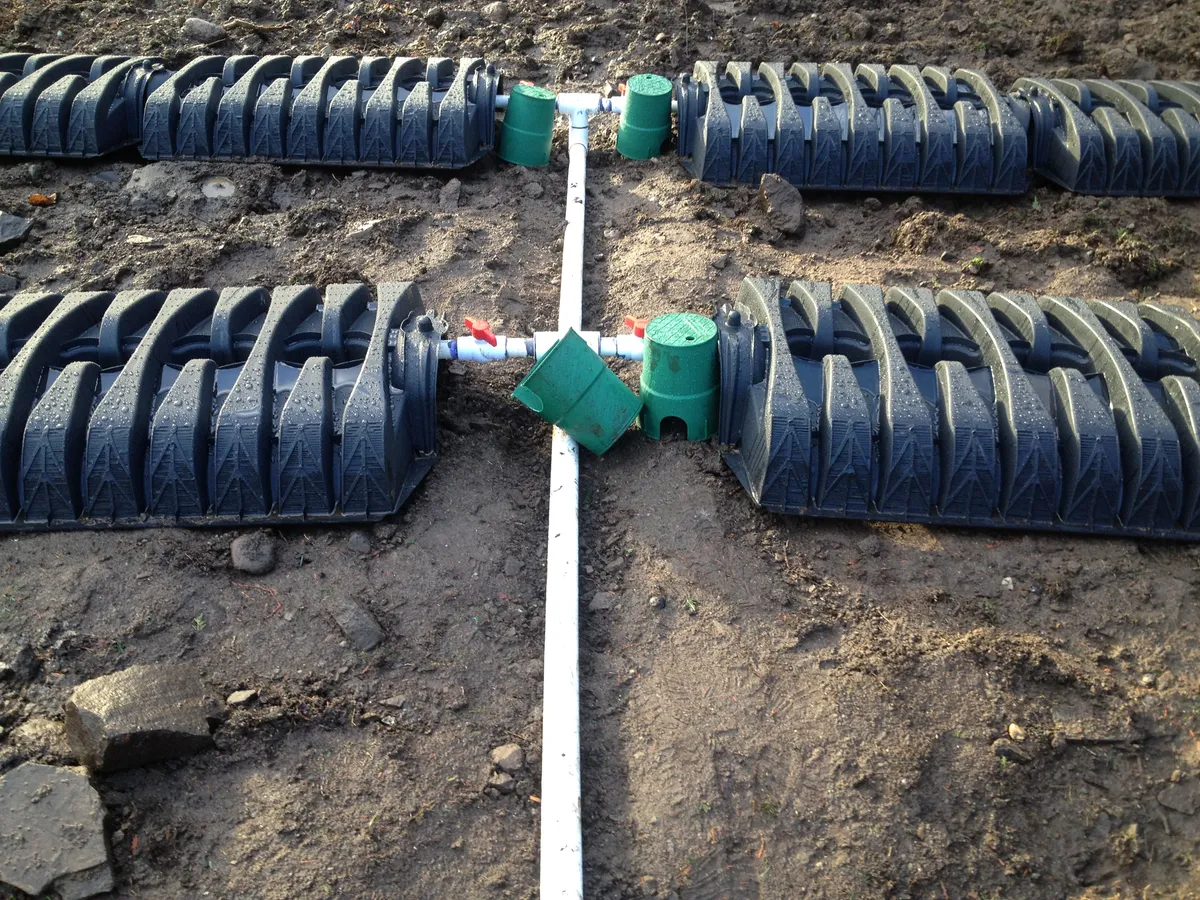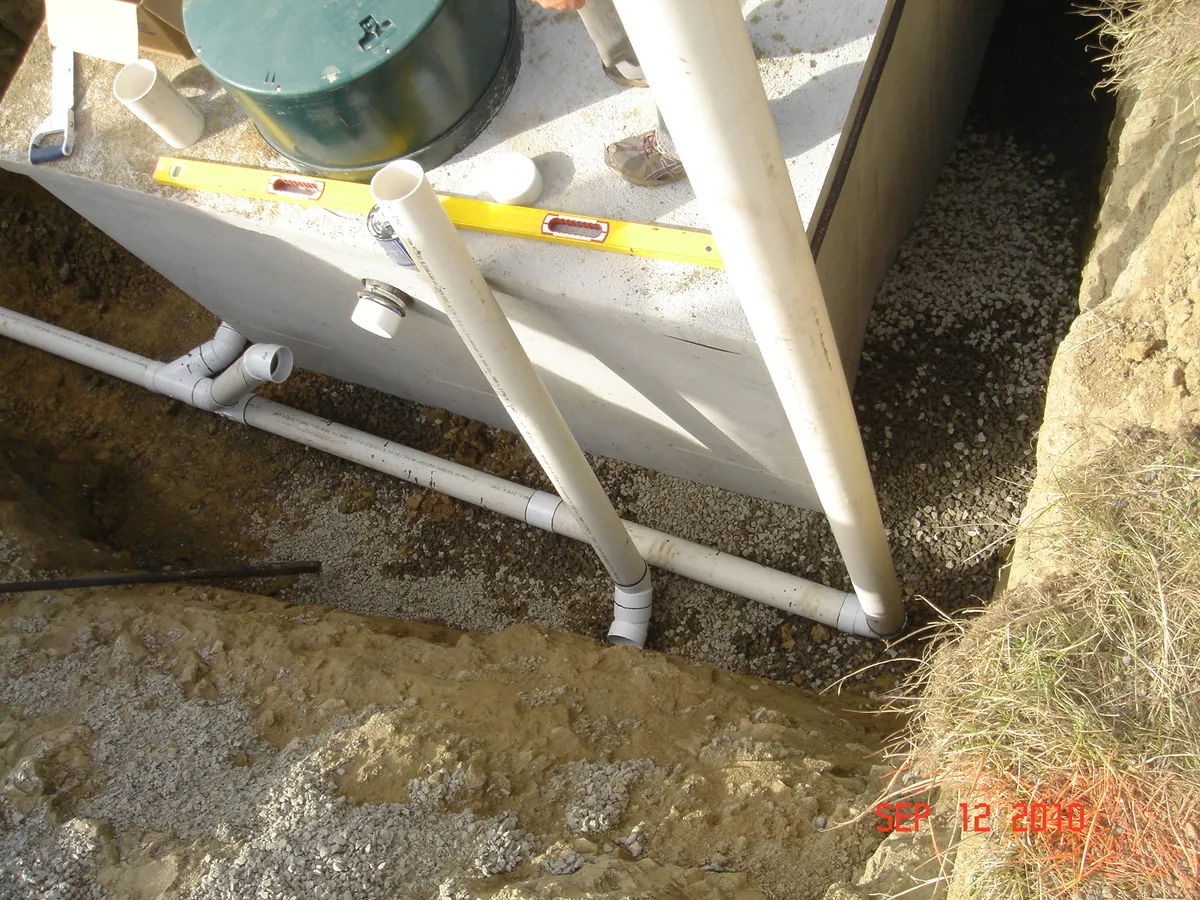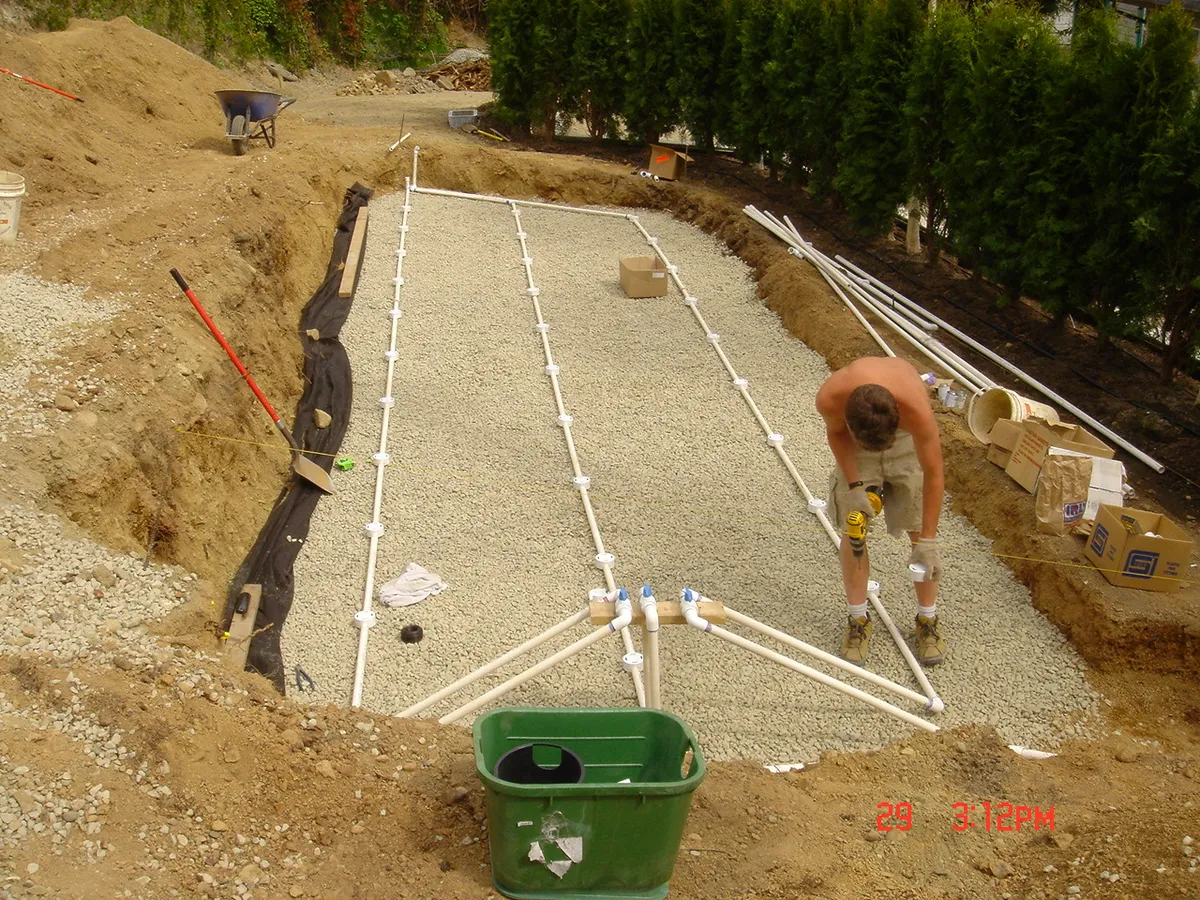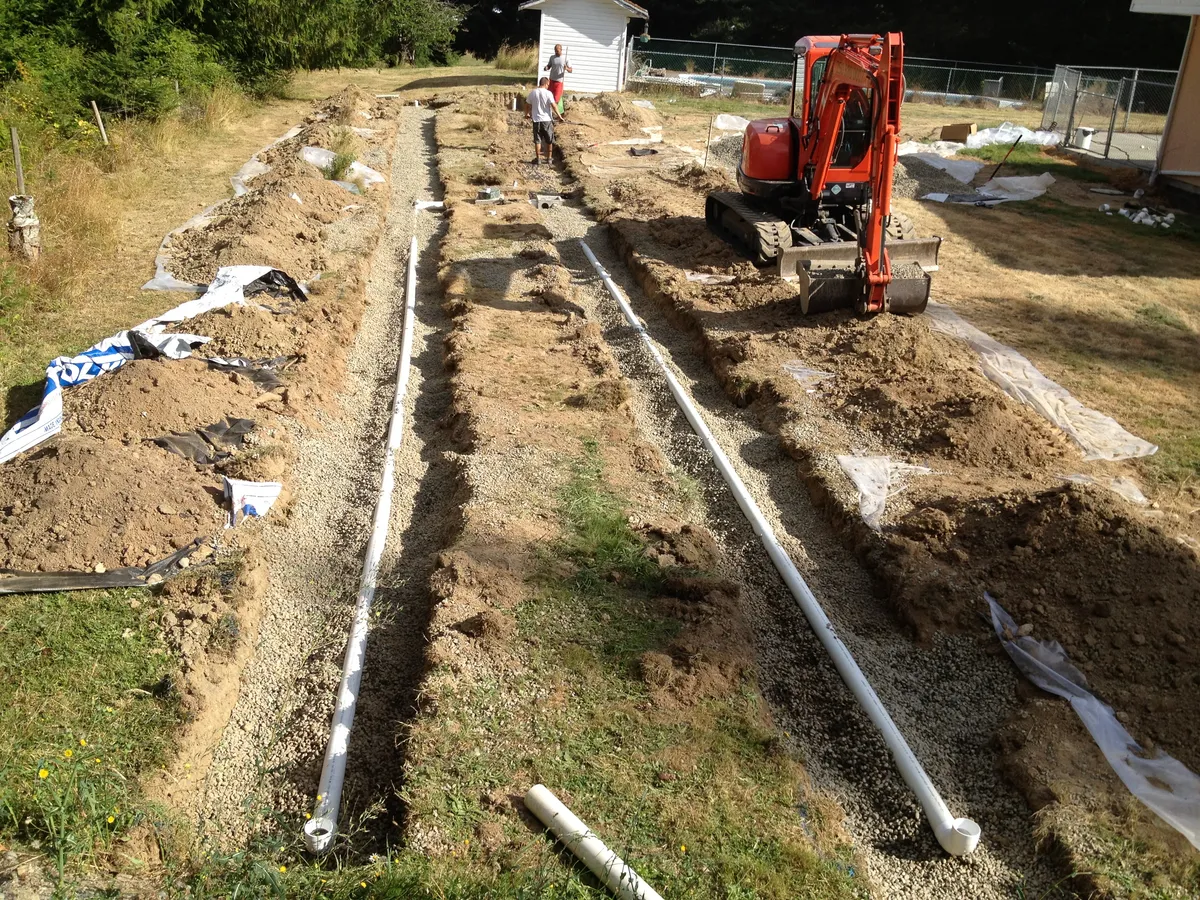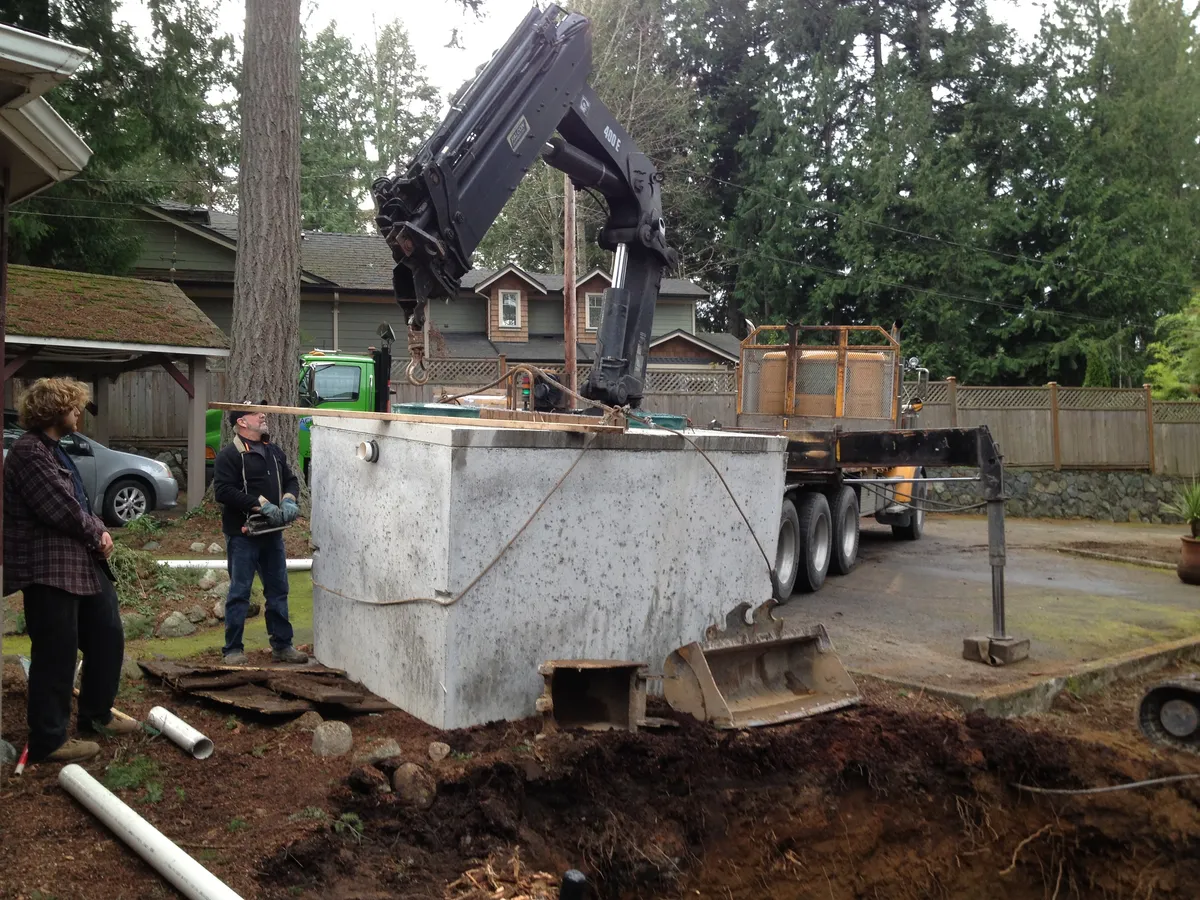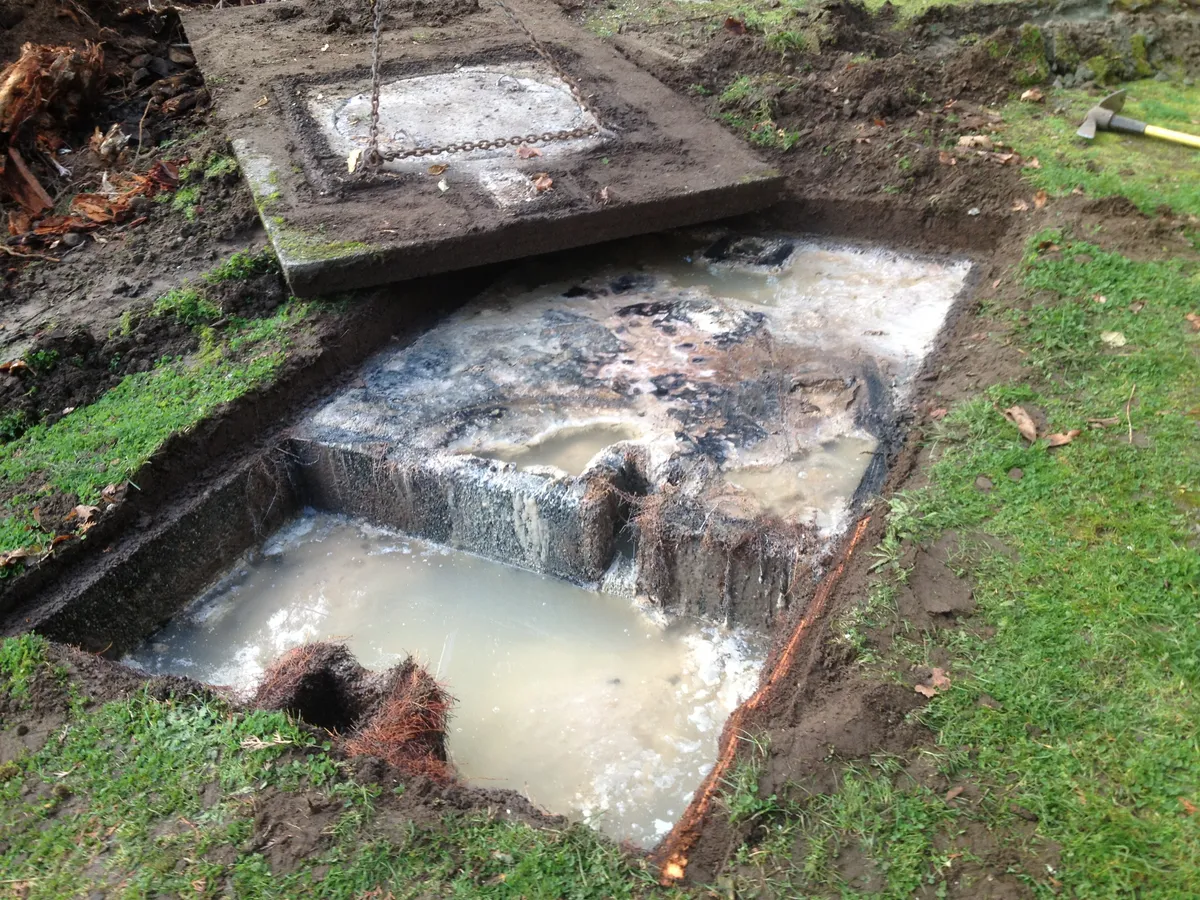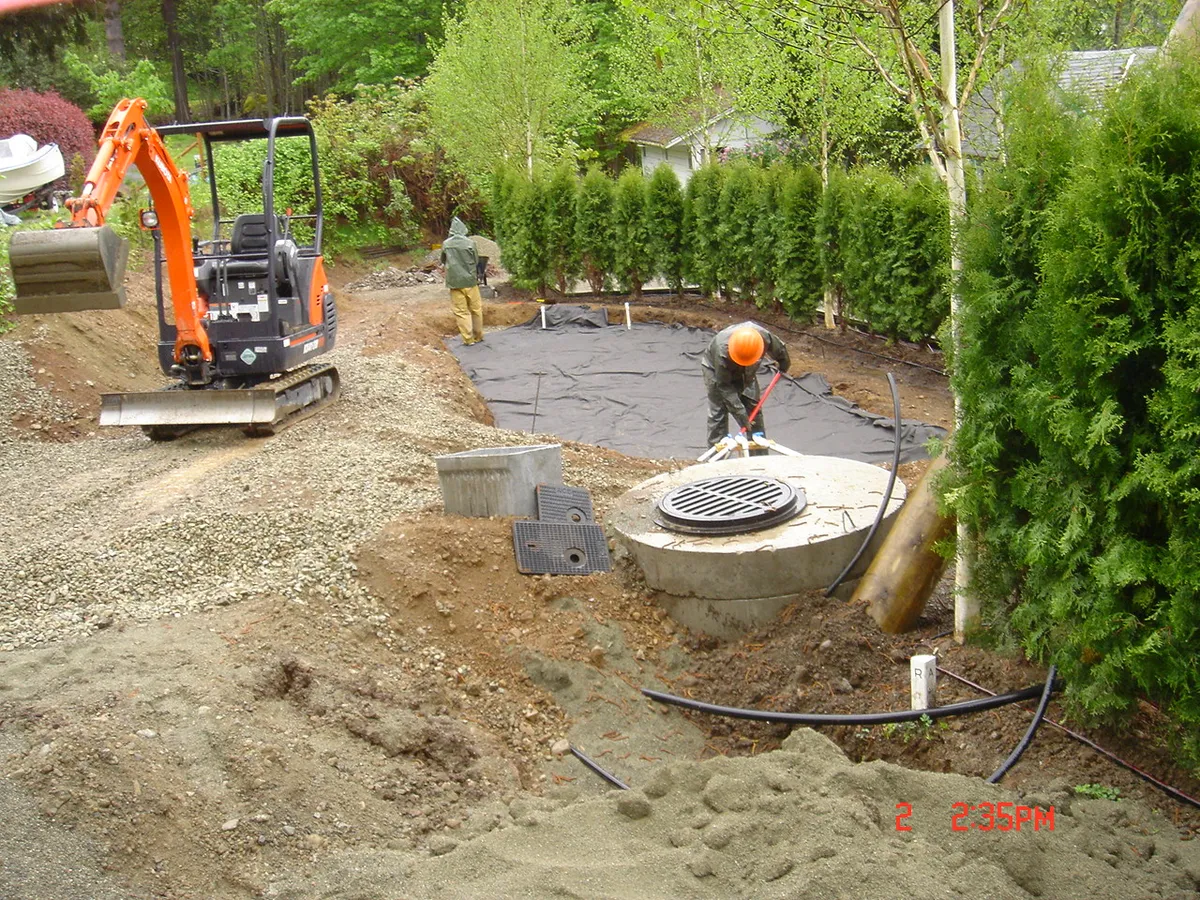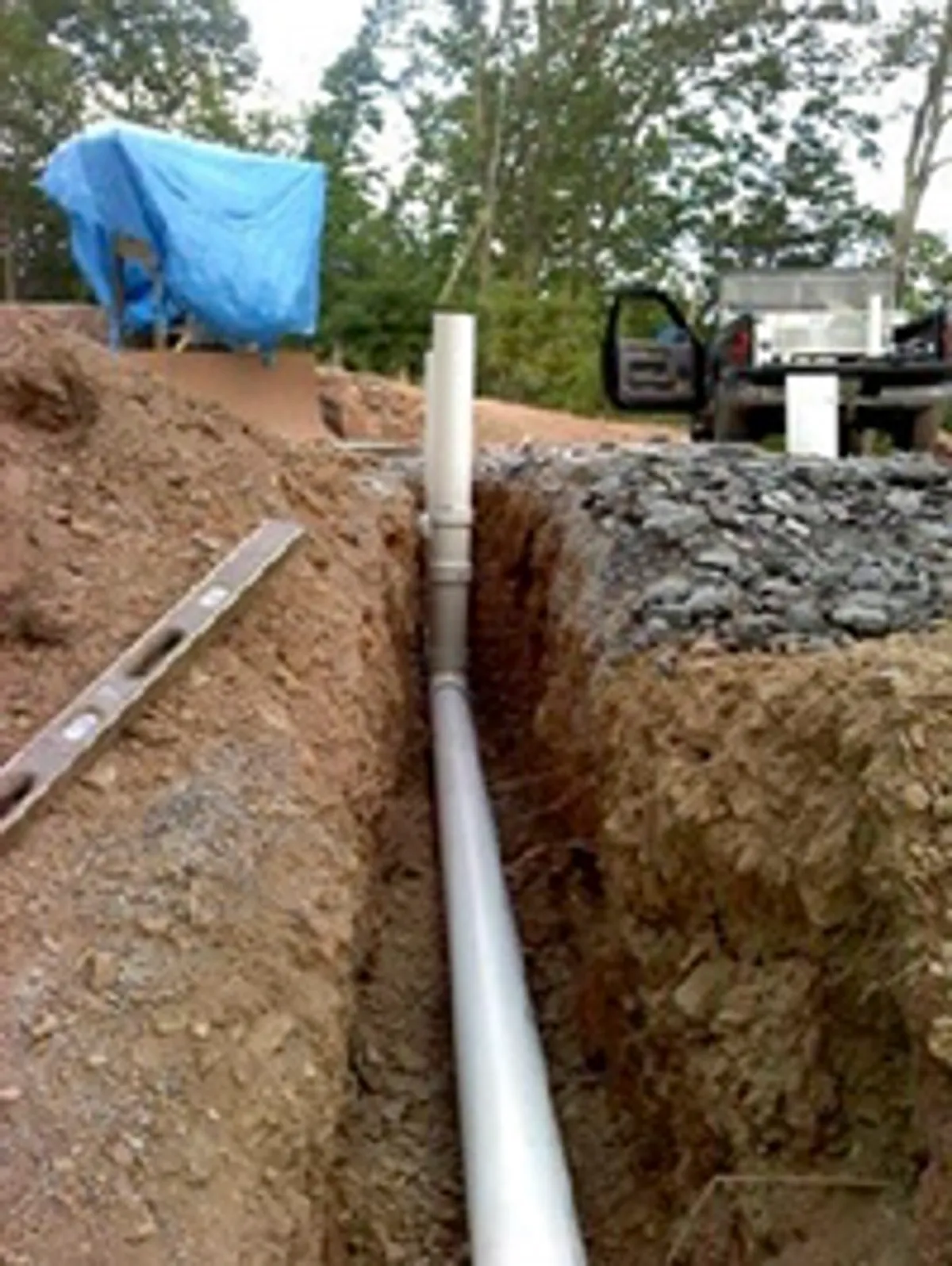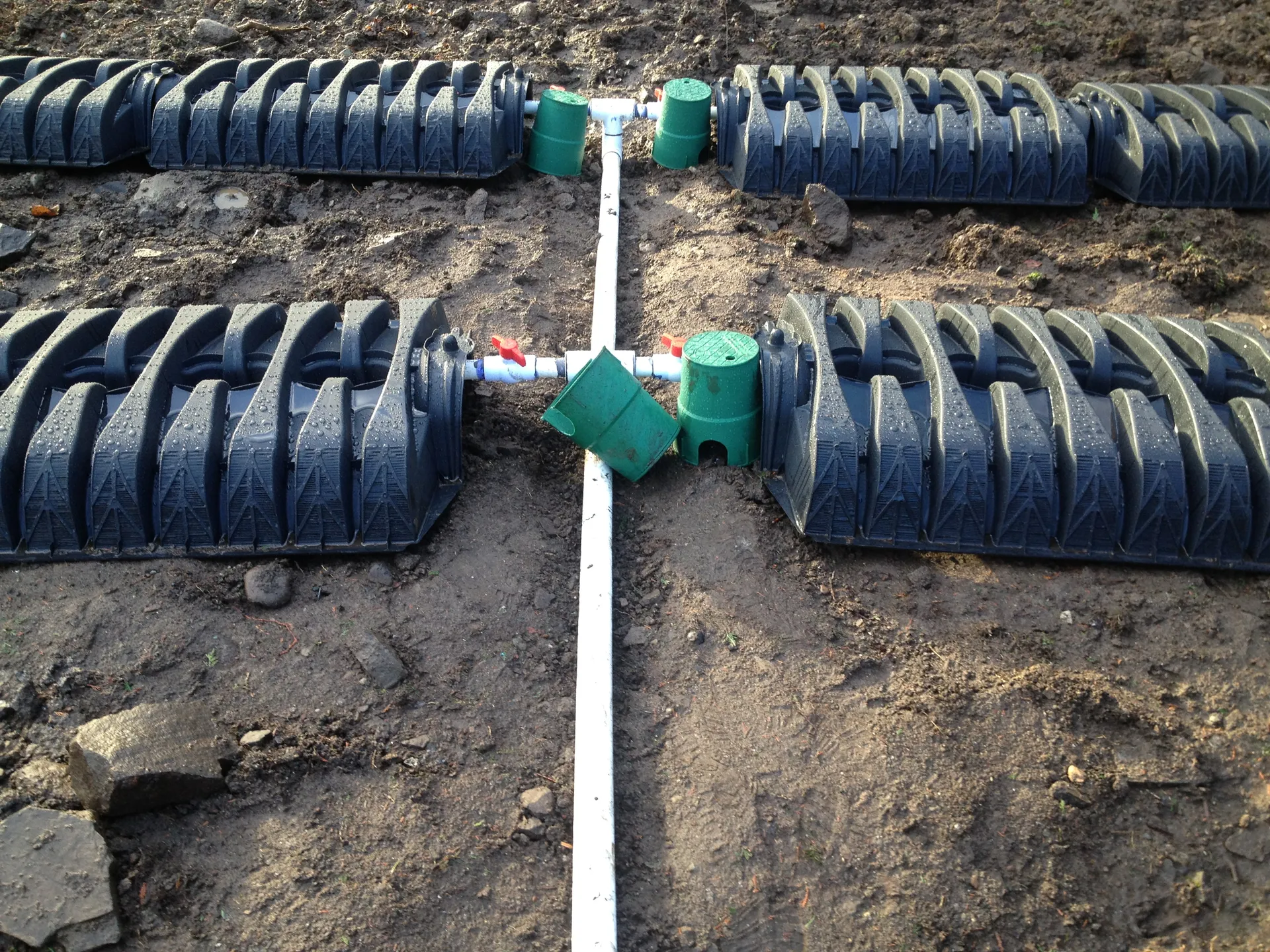
Our Services
Septic System Services
Expert septic system design and installation throughout Vancouver Island. From percolation testing to system installation, we handle every phase with professionalism and compliance with BC regulations.
Get a Free QuoteWhy Choose Pacific Group for Septic Services
Over 30 years of septic system experience with comprehensive knowledge of BC regulations and proper installation methods.
What's Included
Complete septic system design and installation services
Expertise in both conventional and alternative systems
Percolation testing and soil analysis
Ministry of Health permit applications and compliance
Septic tank, treatment plant, and drain field installation
Subdivision feasibility studies and site evaluations
Professional guidance on system selection and sizing
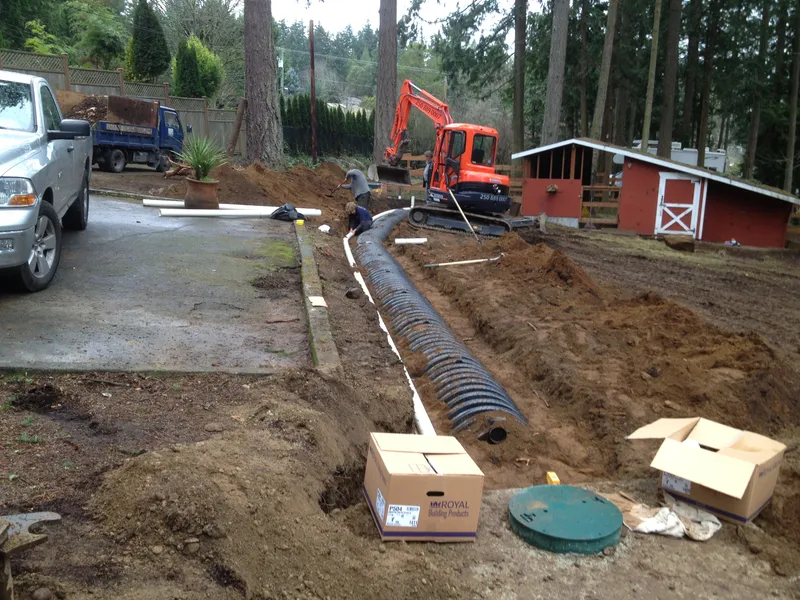
Septic Systems
Comprehensive septic systems tailored to your project needs.
Septic System Design
Professional septic system design based on comprehensive site analysis including percolation tests, soil depth inspection, water table evaluation, and absorption rates. We calculate proper sizing based on residential or commercial use, number of bedrooms and bathrooms, square footage, and occupancy. Design considers setbacks from wells, property lines, watercourses, wetlands, and buildings to ensure compliance and longevity.
Conventional Septic Systems
Installation of gravity septic systems (basic systems using gravity for drainage) and pressure distribution systems (using electric pumps for optimal field efficiency and uniform distribution). Pressure distribution systems can be used where topography doesn't allow gravity systems and provide 100% efficiency in drain field usage, prolonging system life.
Alternative Septic Systems
Installation of aerobic treatment systems that use oxygen to accelerate bacterial decomposition for cleaner effluent, and mound septic systems for areas with insufficient soil depth where systems must be built above ground. Alternative systems are required in sensitive environmental areas, locations with low topsoil depth, or where soil conditions don't suit conventional systems.
Septic Tanks & Components
Installation of concrete, plastic, and fiberglass septic tanks in various sizes. Options include single, double, or triple chamber tanks, forced-sedimentation chambers, baffles, filter ports, and heavy-duty lids. We install risers for easier maintenance access and pump chambers for pressure distribution systems with proper float switches and alarms.
Septic Treatment Plants
Installation of advanced aerobic septic treatment plants that provide superior effluent treatment compared to conventional septic tanks. Treatment plants use oxygen-based processes in three stages—settlement/breakdown, mechanical aeration with aerobic bacteria, and final clarification—producing cleaner effluent that extends drain field life. Includes installation of air compressors, pumps, and alarm systems.
Complete Septic System Services
Pacific Group Developments has been serving Victoria and outlying areas for over 30 years, providing complete septic system services including installation and inspection. We are knowledgeable in all types of septic systems and are eager to assist you with your questions, inspection, and construction needs.
About Septic Systems
A septic system is used to treat sewage and wastewater by allowing the solids to decompose and settle in a tank then letting the liquids to be absorbed by the soil in a drainage field.
The best method of handling residential sewage is through a properly designed and operated community or municipal sewage treatment system. But many areas of British Columbia have populations so low that installation costs prohibit using community systems. In these areas we must rely on individual onsite septic systems for sewage disposal.
Septic systems have improved in recent years and are a great way to treat sewage, provided they’re properly cared for. A septic system needs to meet your specific needs for current and future demands with the health of your family and environmental impact as a main focus. Septic fields can be hazardous to the environment, your family, pets, and costly to repair if not properly taken care of and inspected annually.
Types of Septic Systems
Conventional Septic Systems
Gravity Septic Systems are the most basic systems and use the force of gravity for drainage. The effluent is pulled from the building into the septic tank and from the septic tank into the septic drainage field where it is naturally filtered and further treated before returning to the environment.
Pressure Distribution Systems are the most common septic systems because of their ability to use the drainage field at optimum efficiency. The pressure distribution system can be used in places that gravity septic systems cannot be used due to topography. This system needs an electric pump in a pump tank/pump chamber to pressurize the field, providing 100% efficiency in drain field usage and prolonging system life.
Alternative Septic Systems
Aerobic Treatment Systems use oxygen to promote biological bacteria growth to accelerate decomposition. An acceleration chamber uses forced air to mix the wastewater, accelerating bacteria growth, which results in a cleaner septic system and extended drain field life.
Mound Septic Systems are used when there is not enough soil depth for a traditional septic system. A mound septic system is built above ground level using specific sand fill material for wastewater treatment.
Before installing a septic system, a design is required to be submitted to the Ministry of Health to obtain a permit to construct or alter a septic system.
Septic Tanks
There are many types, shapes, and sizes of septic tanks. A septic tank is a large concrete, plastic, or fiberglass container that’s buried in the yard. Tanks typically hold anywhere from 1,800 litres to 4,500+ litres of sewage.
Types of Septic Tanks
Concrete Septic Tanks are very strong, durable, and do not crack or break easily. The lids can withstand significant weight. Concrete tanks are available with multiple chambers, forced-sedimentation chambers, baffles, filter ports, and heavy-duty lids.
Plastic Septic Tanks are lightweight and easily moved, saving time and reducing crane-truck costs. They’re durable and resilient with ribs for strengthening. However, plastic tanks are not strong enough to drive over without risk of collapse. Many manufacturers include various sewage treatment methods in plastic tanks due to the benefit of being lightweight.
Fiberglass Septic Tanks offer the same weight benefits as plastic tanks but are more brittle in comparison. Like plastic tanks, vehicles and equipment must be kept away to prevent collapse. Many sizes and shapes are available with various internal setups including baffles, chambers, and filter assemblies.
Plastic and fiberglass tanks can only be used once it has been determined that the ground is well drained, as these tanks are lightweight and will float, creating problems. If the soil does not drain well, a drainage system may be installed around the tank to remove groundwater and hydrostatic pressure.
All tank types may be fitted with “risers”—columns with access lids that allow you to cover the tank with more dirt while still accessing the lids for pumping.
Septic Fields (Drain Fields)
A septic field, also known as a leach field, disposal field, or drain field, is a receiving area for effluent after it has broken down and been treated in a septic tank or septic treatment plant.
Types of Septic Fields
Gravity System uses 4” perforated PVC pipe laid in trenches approximately 30” deep and 16” wide, filled with drain rock. Trenches are typically spaced about 6 feet apart. This system is gravity fed and requires no pumping but can’t attain 100% efficiency.
Pressure Distribution System uses an electric sewage effluent pump to pressurize all pipes evenly. The pipe (usually 1” or 1.25” PVC) has 3/16” holes drilled every 2 to 3 feet from which effluent is discharged. This system uses the entire drain field evenly, enhancing treatment and prolonging field life. The dosing and resting cycles prolong retention times in the septic tank and field.
Sand Filter Septic System can be installed above or below ground. Effluent from the pump tank gets pretreatment by intermediate sand before entering the drainage field. This is a good alternative where soil is insufficient for wastewater treatment.
Mound Septic System is used where soil is not deep enough for traditional systems. The drainage system is raised above the natural soil surface with specific sand fill material placed on top of natural soil for effluent treatment.
Septic Treatment Plants
Septic treatment plants are a relatively new development in septic waste management. They have many benefits over conventional systems, treating effluent thoroughly and reducing particulate entering the field, which extends drain field life expectancy.
How Treatment Plants Work
All septic treatment plants use the aerobic (with oxygen) digestion process to treat sewage. Oxygen-using bacteria attack and break down organic portions of sewage into simpler inorganic compounds. Aerobic treatment is preferred because it’s rapid, relatively odor-free, and provides greater solids reduction.
Three Stages of Treatment
Stage 1: Raw sewage enters the system and large particles are settled out or broken up mechanically to increase surface area and make them more accessible to aerobic bacteria.
Stage 2: Mechanical aeration where oxygen-containing air is mixed and blended with mixtures of solids and liquid. Aerobic bacteria reduce the sewage into simple compounds.
Stage 3: Settling or clarification chamber where treated sewage settles. Heavier solids are returned to the aeration chamber for further processing. Clarified liquid flows or is pumped out to the drain field.
Treatment plants rely on mechanical parts, air pumps, and usually an effluent pump. An audible and visual alarm alerts homeowners to problems, preventing costly damage to the disposal field. All components require electricity.
Warning Signs of Failure
All septic systems have a limited life expectancy. Signs of failure include:
- Dark-green grass over leach field area
- Septic odor
- Backup in the house or gurgling noises/slow flush
- Septic water surfacing in the yard
- Sludge on top of baffles in septic tank
If you experience any of these symptoms, contact us immediately. Failing systems can expose you, your family, and neighbors to sewage containing pathogens and viruses that cause disease. Sewage can also contaminate groundwater and surface water, polluting wells, streams, rivers, or lakes.
Subdivisions & Land Development
Subdivisions of land in rural areas without municipal or community sewer service require larger minimum lot sizes to accommodate septic systems. Anyone wanting to subdivide land must prove the land’s ability to provide safe onsite sewage disposal and, in most cases, must prove both a primary septic drain field area and a reserve septic drain field area. This reserve area provides onsite sewage disposal in the future after the primary drain field fails or for expansion.
We offer site evaluations for septic system design, installation, inspection, and feasibility studies for subdivision of property.
Professional & Compliant
Our experienced technicians understand BC’s septic system regulations and ensure complete compliance with Ministry of Health requirements. We provide professional guidance throughout the entire process, from initial site evaluation through final inspection, ensuring your septic system is properly designed and installed for long-term performance and environmental protection.
Project Gallery
Our Septic Systems Work
Browse photos from our recent septic systems projects across Vancouver Island.
Project Types We Handle
New residential septic system installation
Commercial septic and treatment systems
Septic system replacement and upgrades
Subdivision feasibility studies
Septic tank and drain field installation
Our Septic System Process
From initial site evaluation through final inspection, we handle septic projects with professionalism and complete regulatory compliance.
Site Evaluation & Design
Conduct percolation tests and dig inspection holes to establish native soil depths, water table levels, saturated soil conditions, slope, soil type, and absorption rates. Determine usage type (residential, commercial, industrial), calculate requirements based on bedrooms, bathrooms, square footage, and occupancy. Consider all required setbacks and design appropriate system type and size.
Permits & Planning
Prepare detailed septic system design drawings and specifications. Submit design to Ministry of Health for permit approval. Coordinate utility locates and site access. Schedule installation with proper equipment and materials ordered including tanks, pipes, gravel, and all components.
Installation
Excavate for septic tank, pump chamber (if needed), and drain field trenches or beds. Install tanks with proper bedding and backfill. Install all piping, distribution boxes, pumps, and electrical components. Construct drain field with proper gravel or sand, pipe spacing, and depth. Install risers for future access.
Inspection & Completion
Ministry of Health inspection of completed installation to verify compliance with approved design and regulations. Test all mechanical components including pumps, floats, and alarms. Provide homeowner education on system operation and proper usage. Deliver all documentation including permits and inspection certificates.
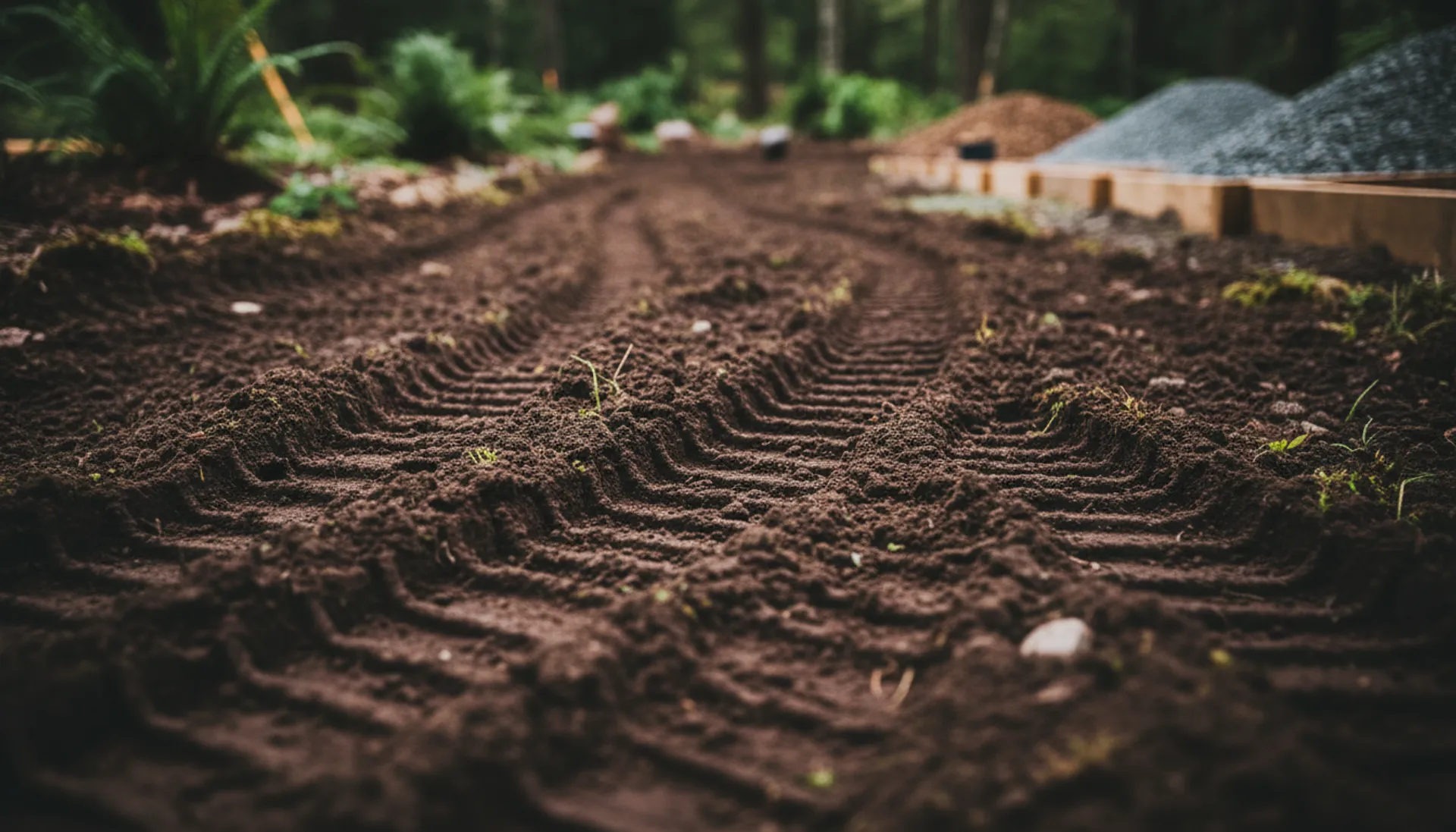
Get Started Today
Need Septic System Services?
Get a free, no-obligation quote for septic system design, installation, or inspection anywhere on Vancouver Island.
Serving all of Vancouver Island
What Our Customers Say
Hear from customers who have experienced our septic systems services.
Our experience with Kelsey and Pacific Group Developments began when we ran into unexpected problems with yet another renovation project in our older victoria home, our septic system. Due to the nature of the septic project, and the fact that we have young children and dogs, we wanted it dealt with quickly, and were pleasantly surprised that Kelsey responded quickly to our request and showed up when expected. He took the time to talk to us and clearly outline our septic system options, while coming up with solutions to creatively address our specific needs and limitations. He squeezed us into a full schedule because of our situation and they were completed ahead of schedule and under budget, a first for us during our 6 years of renovations. Throughout the process everyone involved was knowledgeable, professional, and went above and beyond anything we had expected. We are grateful for everything Kelsey and his crew have done for us, and we are happy to recommend their services!
- Daxter and Emily Granlin
We want to pass on to anyone who is thinking of hiring Kelsey and his team at Pacific Group Developments, you really can’t go wrong. We ran into serious septic system issues and quite honestly we were rescued!
Kelsey and his team took on the huge task almost immediately.
This meant a new septic system which included logging and subsequent landscaping , with confidence that gave us peace of mind. Any and all questions where addressed with much patience and answered until we completely understood. We were very much included in the whole process no matter how small of detail. Due to the issues we had with our situation, Kelsey was able to give us a solution that we felt had come from sound and long term experience. We now have a perfectly operating septic field that is up to code, very easy to maintain and most importantly registered with the correct authorities.
We know that we can call Kelsey at any time no matter what the questions may be and he will have the patience and knowledge to address them.
- Jayne and Alan Wynrib
Pacific Group Developments takes great pride in their work. Kelsey, the owner, is very friendly and courteous. He is extremely knowledgeable about landscaping, drainage, septic systems and concrete works. The staff he employees keep the work site clean. He was always available and responsive to our needs. Even after the job completed, he was available for follow-up. We would recommend Kelsey to family and friends that want the work done right, the first time.
- Shane and Anne H
Frequently Asked Questions
Common questions about our septic systems services.
What is the difference between conventional and alternative septic systems?
How do I know what type of septic system I need?
What is a septic treatment plant and how is it different from a regular septic tank?
Do I need a reserve drain field area?
When do I need to upgrade my existing septic system?
What should I avoid putting in my septic system?
What are signs that my septic system is failing?
Related Services
Explore our other services that complement septic systems.
Landscaping & Hardscaping
Professional landscaping and hardscaping including complete land development solutions.
Excavation & Site Services
Site clearing, foundations, rock and concrete breaking, underground utilities, and complete site preparation.
Perimeter Drains & Waterproofing
Foundation drainage systems, basement waterproofing, drain cleaning, and complete drainage solutions for wet basements.
